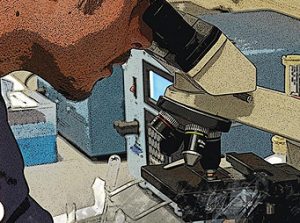The Evolution of Test Tube Babies
Click here to read the complete article88 – Aug/Sept, 2018
BY TAYLOR FABUS
 Each year, the scientific community is racing forward to improve fertility and reproductive efficiency. Thousands of researchers, graduate students, and industry leaders are working together to improve overall reproductive health and productivity. Historically, the equine industry has evolved from live cover to assisted reproductive technologies, such as artificial insemination (AI) and embryo transfer (ET). Recently, researchers and clinicians have turned to a technique known as intracytoplasmic sperm injection (ICSI, pronounced “ick-see”) for the production of valuable foals, as well as an option for species preservation. The typical ICSI procedure involves extracting eggs from a mare’s ovary, retrieving a sperm sample, and then manually injecting a sperm into an egg within a laboratory dish where fertilization can occur. Following a week of development in culture, the resulting embryo can then be transferred to the uterus of a recipient mare. However, ICSI in horses is technically challenging and usually results in significantly lower pregnancy establishment as compared to other assisted reproductive techniques like AI and ET.
Each year, the scientific community is racing forward to improve fertility and reproductive efficiency. Thousands of researchers, graduate students, and industry leaders are working together to improve overall reproductive health and productivity. Historically, the equine industry has evolved from live cover to assisted reproductive technologies, such as artificial insemination (AI) and embryo transfer (ET). Recently, researchers and clinicians have turned to a technique known as intracytoplasmic sperm injection (ICSI, pronounced “ick-see”) for the production of valuable foals, as well as an option for species preservation. The typical ICSI procedure involves extracting eggs from a mare’s ovary, retrieving a sperm sample, and then manually injecting a sperm into an egg within a laboratory dish where fertilization can occur. Following a week of development in culture, the resulting embryo can then be transferred to the uterus of a recipient mare. However, ICSI in horses is technically challenging and usually results in significantly lower pregnancy establishment as compared to other assisted reproductive techniques like AI and ET.
In April of 2018, University of California Davis announced that they had the first foal born at their facility by ICSI. Although the first live foal was born from this procedure more than fifteen years ago, the clinical use of ICSI has grown substantially since, and this foal is an exciting step for UC Davis scientists. One of the lead researchers, Dr. Stuart Meyers, a reproductive biologist from UC Davis, is a pioneer in the area of sperm cell function and development. His lab is working to develop methods in which mammalian sperm preservation and fertility can be advanced. Dr. Meyers utilizes horses, in addition to two different species of monkeys, as an animal model to perform his research.
“This is the first all-UC Davis ICSI pregnancy and the result of a great team effort among veterinary scientists and clinicians,” says Dr. Stuart Meyers. He says, “We obtained the eggs, matured them in vitro, performed ICSI fertilization, grew the embryos to blastocyst, and then transferred to a recipient mare.” In 2015, the UC Davis Veterinary Hospital’s Equine Reproduction Service obtained a pregnancy by aspirating eggs from a client mare, shipping the eggs to Texas A&M University for ICSI, and bringing the embryo back to Davis for transfer and pregnancy.
Click here to read the complete article88 – Aug/Sept, 2018










